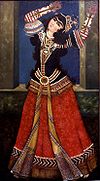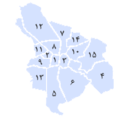| Part of a series on the |
| Culture of Iran |
|---|
 |
|
|
In 2006 Isfahan was named Cultural Capital of the Islamic world, by the Organization of the Islamic Conference. Isfahan is the home of several UNESCO World Cultural Heritage Sites. The Naqsh-e Jahan Square (Shah Square) was built in the early 16th century when Isfahan was the capital of the Safavid empire, and it was one of the first sites in Iran to be inscribed on the World Heritage list, in 1979, and the Jameh Mosque of Isfahan was designated a World Cultural Heritage site in 2012. In addition, the Chehel Sotoun Palace in Isfahan is one of the nine sites around Iran that is part of the World Cultural Heritage site Persian gardens, inscribed on the list in 2011.
The University of Isfahan Entertainment Industry Innovation Center offers education in computer game design and development. Municipality of Isfahan Social, Cultural and Sports Organization (established in 1997) is one of the affiliated organizations of Isfahan Municipality.
There are more than 100 cultural and sports centers in the city. Isfahan joined the UNESCO Creative Cities Network in 2015.
Gallery
-
 Isfahan
Isfahan
-
 Hasht Behesht
Hasht Behesht
-
 Horse shah abas square
Horse shah abas square
-
 map by Coste
map by Coste
See also
Further reading
- An Analysis of Isfahan citizenship culture
- Book Arts of Isfahan: Diversity and Identity in Seventeenth-Century Persia
- THE IDENTITY COMPONENTS FOR HISTORIC QUARTER OF CITY SURROUNDING CONTEXT OF JAME MOSQUE OF ISFAHAN
- From Pahlavi Isfahan to Pacific Shangri La: Revivıng, Restoring, and Reinventing Safavid Aesthetıcs, ca. 1920–40
References
- "Isfahan set to become Cultural Capital of Islam for 2006" (Press release). Mehr News Agency. 9 January 2006. Retrieved 7 October 2020.
- "Meidan Emam, Esfahan". UNESCO World Heritage Centre. Archived from the original on 2020-10-02. Retrieved 2020-10-07.
- "Report of the 3rd Session of the Committee". UNESCO. 30 November 1979. Retrieved 7 October 2020.
- "Masjed-e Jāmé of Isfahan". UNESCO World Heritage Centre. Archived from the original on 2020-06-30. Retrieved 2020-10-07.
- "The Persian Garden". UNESCO World Heritage Centre. Retrieved 7 October 2020.
- "داستان ما". uicvgame.ui.ac.ir. University of Isfahan. Retrieved 2020-10-07.
- "درباره ما". www.esfahanfarhang.ir. Archived from the original on 2020-08-10. Retrieved 2020-10-07.
- "Isfahan, UNESCO City of Crafts and Folk Arts, 2015-2019 Monitoring Report" (PDF). UNESCO.
- "SID.ir | تحليلي بر فرهنگ شهروندي در شهر اصفهان". 2020-09-11. Archived from the original on 2020-09-11. Retrieved 2020-10-07.
{{cite web}}: CS1 maint: bot: original URL status unknown (link) - Taylor, Alice (1995). Book Arts of Isfahan: Diversity and Identity in Seventeenth-Century Persia. ISBN 978-0892363629.
- Hossein, Saraei Mohammad; Fariba, Bahrami; Shirin, Mohrehkesh (Summer 2012). "The identity components for historic quarter of city surrounding context of Jame Mosque of Ishafan". Journal of Studies on Iranian Islamic City. 2 (8). Archived from the original on 25 September 2020. Retrieved 25 September 2020.
- Overton, Keelan (2012). "From Pahlavi Isfahan to Pacific Shangri La: Revivıng, Restoring, and Reinventing Safavid Aesthetıcs, ca. 1920–40". West 86th: A Journal of Decorative Arts, Design History, and Material Culture. 19: 61–87. doi:10.1086/665682. Archived from the original on 25 September 2020. Retrieved 25 September 2020.
External links
- Municipality culture & sports organization
- Department of Cultural heritage of Isfahan Province Archived 2010-08-20 at the Wayback Machine
- World heritage sites of Isfahan Archived 2021-01-21 at the Wayback Machine
- ministry of islamic culture & guidance Archived 2020-10-18 at the Wayback Machine
- http://park.isfahan.ir/parklocations Archived 2020-10-15 at the Wayback Machine
- http://park.isfahan.ir/madiha Archived 2020-07-19 at the Wayback Machine
| Iranian cuisine | |||||||||
|---|---|---|---|---|---|---|---|---|---|
| Ingredients |
| ||||||||
| Breads and nans | |||||||||
| Salads |
| ||||||||
| Cheeses | |||||||||
| Soups and āshes |
| ||||||||
| Dishes |
| ||||||||
| Sauces | |||||||||
| Hors d'oeuvre | |||||||||
| Sweets and desserts | |||||||||
| Beverages | |||||||||
| Instruments | |||||||||
| Related cuisines | |||||||||
| Iranian architecture | ||||||
|---|---|---|---|---|---|---|
| Periods |
|  | ||||
| Types | ||||||
| Elements | ||||||
| Traditional cities | ||||||
| Theory and analysis | ||||||
| Lists | ||||||
| Culture of Asia | |
|---|---|
| Sovereign states |
|
| States with limited recognition | |
| Dependencies and other territories | |
| National symbols of Iran | |
|---|---|
| Flag | The Three-Color Flag |
| Emblems |
|
| Anthems |
|
| Iranian news agencies and websites | |
|---|---|
| News Agencies | |
| News websites | |
| Colleges and universities in Isfahan | |
|---|---|
|
 | ||
